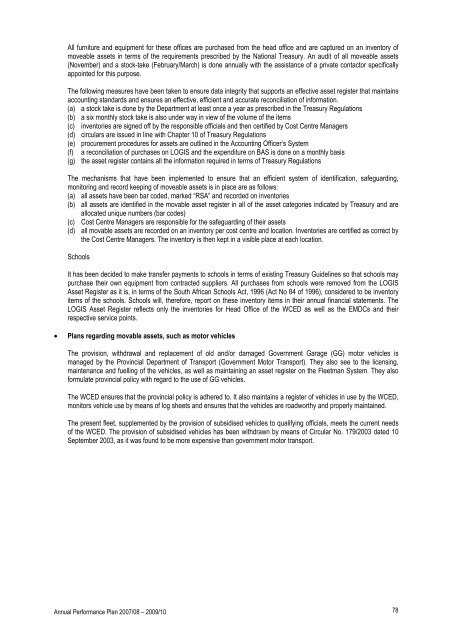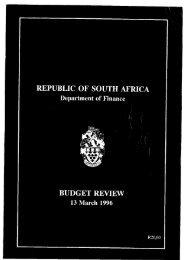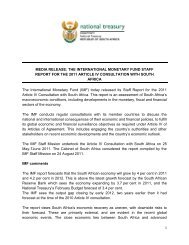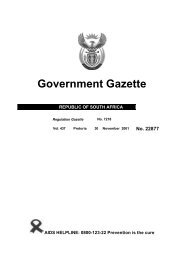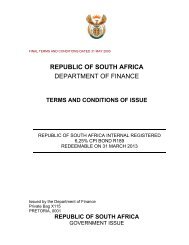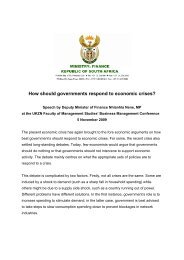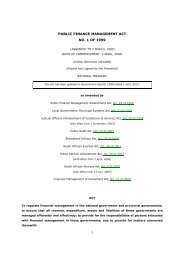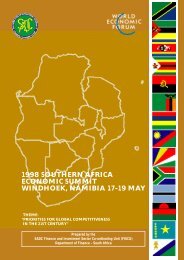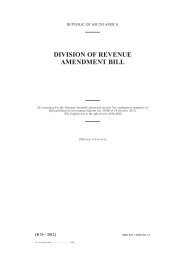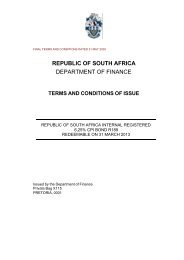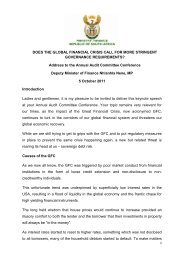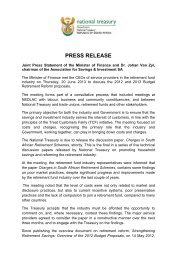Annual Performance Plan Jaarlikse ... - National Treasury
Annual Performance Plan Jaarlikse ... - National Treasury
Annual Performance Plan Jaarlikse ... - National Treasury
You also want an ePaper? Increase the reach of your titles
YUMPU automatically turns print PDFs into web optimized ePapers that Google loves.
All furniture and equipment for these offices are purchased from the head office and are captured on an inventory of<br />
moveable assets in terms of the requirements prescribed by the <strong>National</strong> <strong>Treasury</strong>. An audit of all moveable assets<br />
(November) and a stock-take (February/March) is done annually with the assistance of a private contactor specifically<br />
appointed for this purpose.<br />
The following measures have been taken to ensure data integrity that supports an effective asset register that maintains<br />
accounting standards and ensures an effective, efficient and accurate reconciliation of information.<br />
(a) a stock take is done by the Department at least once a year as prescribed in the <strong>Treasury</strong> Regulations<br />
(b) a six monthly stock take is also under way in view of the volume of the items<br />
(c) inventories are signed off by the responsible officials and then certified by Cost Centre Managers<br />
(d) circulars are issued in line with Chapter 10 of <strong>Treasury</strong> Regulations<br />
(e) procurement procedures for assets are outlined in the Accounting Officer’s System<br />
(f) a reconciliation of purchases on LOGIS and the expenditure on BAS is done on a monthly basis<br />
(g) the asset register contains all the information required in terms of <strong>Treasury</strong> Regulations<br />
The mechanisms that have been implemented to ensure that an efficient system of identification, safeguarding,<br />
monitoring and record keeping of moveable assets is in place are as follows:<br />
(a) all assets have been bar coded, marked “RSA” and recorded on inventories<br />
(b) all assets are identified in the movable asset register in all of the asset categories indicated by <strong>Treasury</strong> and are<br />
allocated unique numbers (bar codes)<br />
(c) Cost Centre Managers are responsible for the safeguarding of their assets<br />
(d) all movable assets are recorded on an inventory per cost centre and location. Inventories are certified as correct by<br />
the Cost Centre Managers. The inventory is then kept in a visible place at each location.<br />
Schools<br />
It has been decided to make transfer payments to schools in terms of existing <strong>Treasury</strong> Guidelines so that schools may<br />
purchase their own equipment from contracted suppliers. All purchases from schools were removed from the LOGIS<br />
Asset Register as it is, in terms of the South African Schools Act, 1996 (Act No 84 of 1996), considered to be inventory<br />
items of the schools. Schools will, therefore, report on these inventory items in their annual financial statements. The<br />
LOGIS Asset Register reflects only the inventories for Head Office of the WCED as well as the EMDCs and their<br />
respective service points.<br />
• <strong>Plan</strong>s regarding movable assets, such as motor vehicles<br />
The provision, withdrawal and replacement of old and/or damaged Government Garage (GG) motor vehicles is<br />
managed by the Provincial Department of Transport (Government Motor Transport). They also see to the licensing,<br />
maintenance and fuelling of the vehicles, as well as maintaining an asset register on the Fleetman System. They also<br />
formulate provincial policy with regard to the use of GG vehicles.<br />
The WCED ensures that the provincial policy is adhered to. It also maintains a register of vehicles in use by the WCED,<br />
monitors vehicle use by means of log sheets and ensures that the vehicles are roadworthy and properly maintained.<br />
The present fleet, supplemented by the provision of subsidised vehicles to qualifying officials, meets the current needs<br />
of the WCED. The provision of subsidised vehicles has been withdrawn by means of Circular No. 179/2003 dated 10<br />
September 2003, as it was found to be more expensive than government motor transport.<br />
<strong>Annual</strong> <strong>Performance</strong> <strong>Plan</strong> 2007/08 – 2009/10<br />
78


